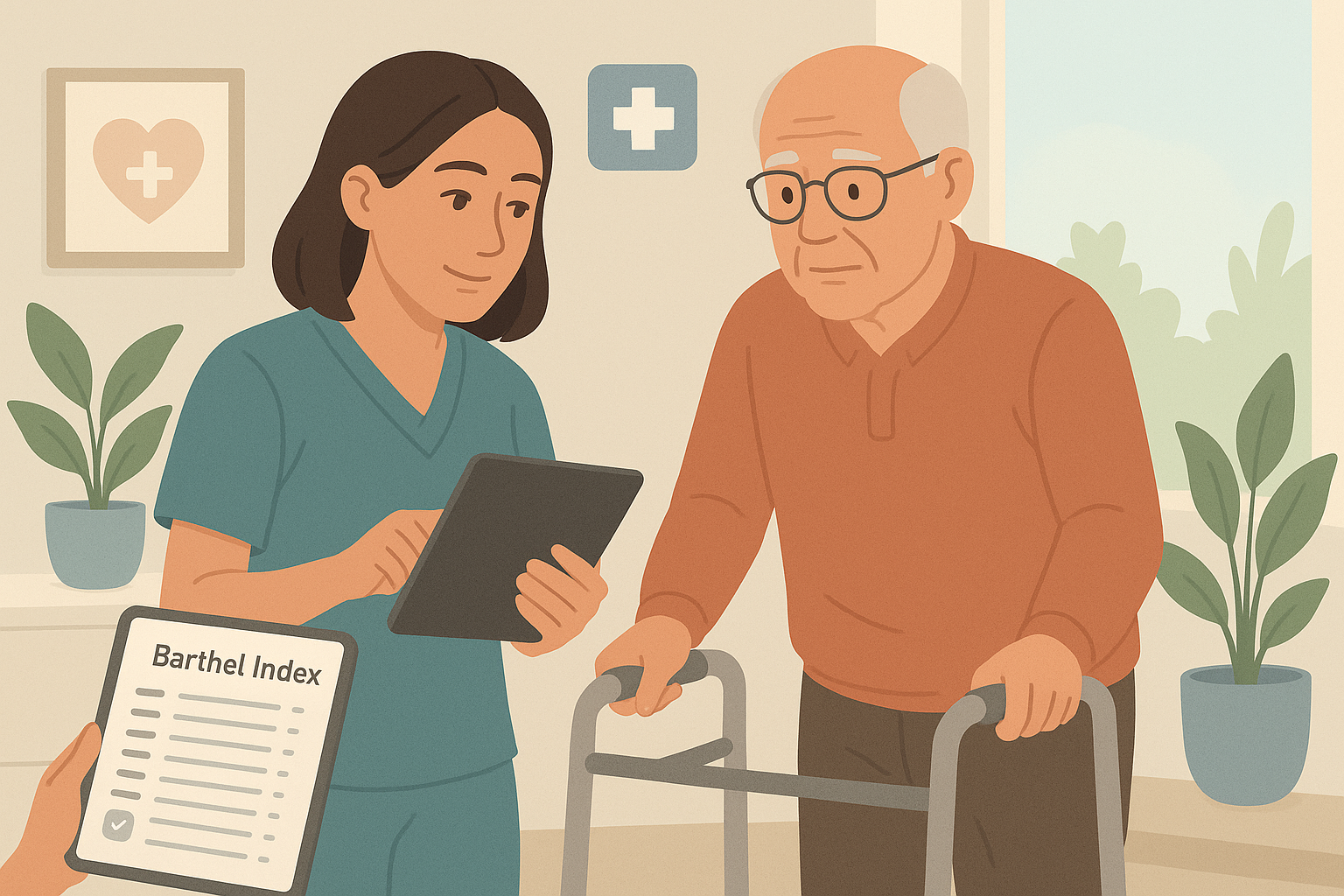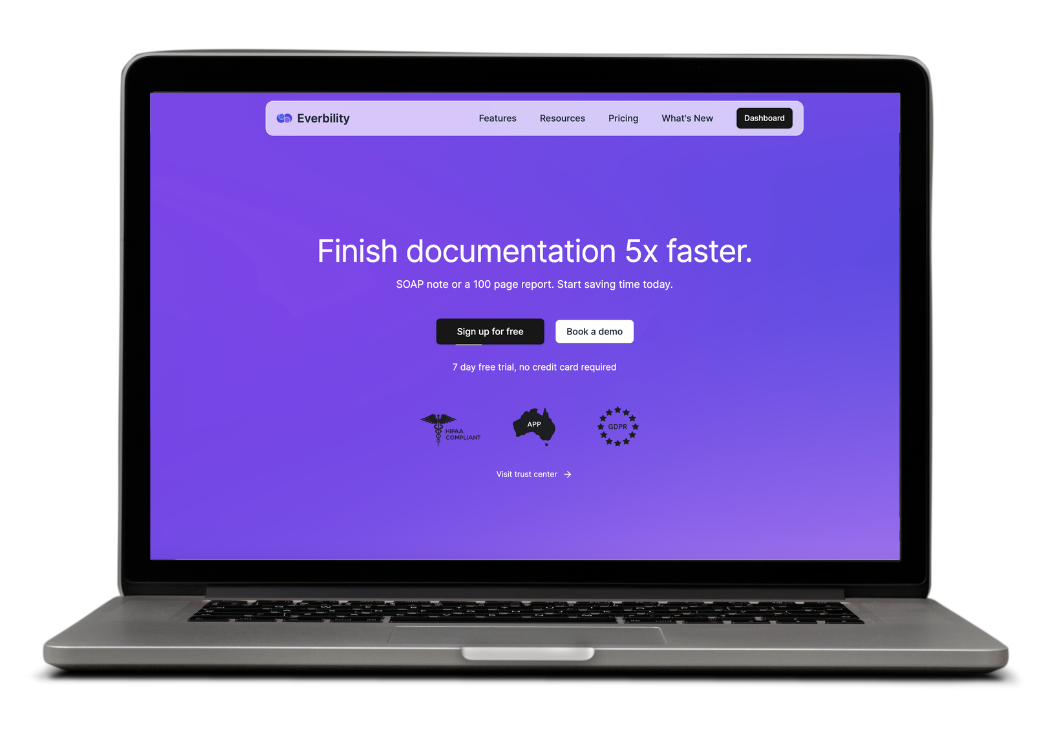- Published on
Why the Barthel Index Still Matters in OT - And How to Use It More Effectively
- Authors
- Name
- Bella Martini

Introduction
- Understanding the Barthel Index in Occupational Therapy
- What is the Barthel Index?
- Why Occupational Therapists Use the Barthel Index
- Practical Examples in Occupational Therapy
- Limitations of the Barthel Index
- Combining Tools for Better Assessment
- Streamlining Documentation with Everbility
- Final Thoughts
- References
Understanding the Barthel Index in Occupational Therapy
In occupational therapy, one of the most important steps in supporting a client is understanding how independently they can manage their day-to-day activities. Therapists need this information to plan interventions, set goals, and track progress. One tool that has stood the test of time in helping therapists do exactly this is the Barthel Index.
Whether you are a new graduate or a seasoned therapist, chances are you have used or heard of the Barthel Index. It is widely recognised across clinical settings as a straightforward, reliable way to assess a client’s ability to perform daily tasks. This blog post will take a deep dive into what the Barthel Index is, how it is used in occupational therapy, its limitations, and how tools like Everbility can enhance the way therapists document and interpret these assessments.
What is the Barthel Index?
The Barthel Index is a functional assessment that evaluates a person’s ability to independently complete ten basic activities of daily living (ADLs). These include:
- Feeding
- Bathing
- Grooming
- Dressing
- Bowel control
- Bladder control
- Toilet use
- Transfers (e.g. from bed to chair)
- Mobility (walking or using a wheelchair)
- Stair use
Each activity is scored based on the level of assistance a person requires to complete it. Scores typically range from 0 (complete dependence) to 100 (complete independence), although some versions use slightly different scoring ranges. The total score provides a clear snapshot of a person's overall level of functional independence.
A high score indicates that the individual can perform most tasks without help, while a lower score suggests that assistance is needed. This information is essential in settings such as hospitals, rehabilitation units, aged care facilities, and community health programs, where understanding functional ability informs decisions about care, discharge planning, and support services.
Why Occupational Therapists Use the Barthel Index
There are several reasons the Barthel Index is a popular choice for occupational therapists:
- It is quick and easy to administer. The assessment usually takes under ten minutes to complete, making it ideal for busy clinical environments.
- It provides objective data. The numerical scores make it easy to communicate findings with other professionals, including doctors, nurses, physiotherapists, and support coordinators.
- It tracks progress over time. By repeating the assessment at different stages of therapy, therapists can see whether an intervention is effective or whether a client’s condition is changing.
- It supports goal setting. The Barthel Index highlights specific areas where a client may need support. This helps in developing therapy goals and strategies tailored to their needs.
- It informs funding and service decisions. In some settings, Barthel Index scores are used to justify funding for home supports, equipment, or additional services.
Practical Examples in Occupational Therapy
Let’s consider a few examples of how the Barthel Index is used in practice:
- A client recovering from a stroke scores low in transfers and mobility. The occupational therapist recommends grab rails, a mobility aid, and works on bed-to-chair transfers during therapy sessions.
- An older adult in aged care struggles with dressing and grooming. The therapist suggests adaptive equipment, such as a long-handled shoehorn and button hook, and provides carer training.
- A patient in a rehabilitation hospital improves their score significantly over three weeks, indicating that therapy interventions are effective and discharge may be possible with appropriate community supports.
In each case, the Barthel Index acts as a guide to help the therapist understand functional challenges and plan accordingly.
Limitations of the Barthel Index
Although the Barthel Index is valuable, it is not a comprehensive tool. It focuses solely on physical function and does not account for cognitive, emotional, social, or environmental factors. For example, a person may physically be able to dress themselves but struggle with sequencing due to cognitive impairment. This limitation means therapists often use the Barthel Index in conjunction with other assessments to build a fuller picture.
The tool can also miss subtleties in performance. A person might technically complete a task but do so with great difficulty, pain, or risk, which is not always captured by the scoring system. Additionally, for clients who are already highly independent, the tool may not detect small but meaningful improvements. This is known as the ceiling effect.
Combining Tools for Better Assessment
To overcome these limitations, occupational therapists often pair the Barthel Index with tools such as:
- The Canadian Occupational Performance Measure (COPM)
- The Functional Independence Measure (FIM)
- The Mini-Mental State Examination (MMSE)
- The Assessment of Motor and Process Skills (AMPS)
Using multiple tools ensures a more holistic approach to assessment and care planning.

Streamlining Documentation with Everbility
Documentation is a major part of any therapist’s workload. It ensures accountability, supports communication, and provides the evidence needed for funding and service delivery. However, it can also be time-consuming and repetitive. That is where Everbility can make a difference.
Everbility is an AI-powered documentation assistant designed specifically for allied health professionals. It allows therapists to:
- Complete assessments like the Barthel Index using structured templates or speech-to-text
- Automatically generate client summaries and progress reports
- Track changes over time with visual trend data
- Maintain secure, compliant records in line with privacy legislation
By integrating tools like the Barthel Index into Everbility, therapists can reduce their admin time and focus more on client care. For example, instead of writing out the full assessment, a therapist can input scores directly into the platform and generate a report with just a few clicks. This report can be shared with the client, their family, or the wider care team.
Final Thoughts
The Barthel Index continues to be a valuable tool for assessing functional independence in occupational therapy. Its simplicity, clarity, and versatility make it an essential part of many therapists’ toolkits. However, like all tools, it is most effective when used as part of a broader assessment strategy. For therapists working across multiple settings or juggling large caseloads, using technology like Everbility can ease the burden of documentation and ensure that assessments like the Barthel Index are completed, stored, and shared efficiently. Ultimately, this creates more space for what matters most: providing high-quality, person-centred care.
Want to see how Everbility works in action?
Click here to book a demo and we’ll walk you through it.
References
- Mahoney, F. I., & Barthel, D. W. (1965). Functional evaluation: The Barthel Index. Maryland State Medical Journal, 14, 61–65.
- Collin, C., Wade, D. T., Davies, S., & Horne, V. (1988). The Barthel ADL Index: a reliability study. International Disability Studies, 10(2), 61–63. https://doi.org/10.3109/09638288809164103
- Shah, S., Vanclay, F., & Cooper, B. (1989). Improving the sensitivity of the Barthel Index for stroke rehabilitation. Journal of Clinical Epidemiology, 42(8), 703–709. https://doi.org/10.1016/0895-4356(89)90065-6
- Law, M., Baptiste, S., McColl, M., Opzoomer, A., Polatajko, H., & Pollock, N. (1990). The Canadian Occupational Performance Measure: An outcome measure for occupational therapy. Canadian Journal of Occupational Therapy, 57(2), 82–87. https://doi.org/10.1177/000841749005700207
- American Occupational Therapy Association. (2020). Occupational therapy practice framework: Domain and process (4th ed.). American Journal of Occupational Therapy, 74(Suppl. 2), 7412410010. https://doi.org/10.5014/ajot.2020.74S2001
- Kinsella, D., & Scott, S. (2023). Digital transformation in allied health: Exploring the role of AI tools like Everbility in clinical practice. Australian Journal of Allied Health Technology, 6(1), 15–23.